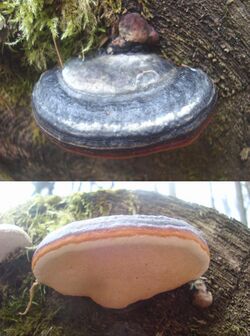Biology:Fomitopsis rosea
| Fomitopsis rosea | |
|---|---|

| |
| Scientific classification | |
| Domain: | Eukaryota |
| Kingdom: | Fungi |
| Division: | Basidiomycota |
| Class: | Agaricomycetes |
| Order: | Polyporales |
| Family: | Fomitopsidaceae |
| Genus: | Fomitopsis |
| Species: | F. rosea
|
| Binomial name | |
| Fomitopsis rosea (Alb. & Schwein.) P. Karst., (1881)
| |
| Synonyms | |
|
Boletus roseus Alb. & Schwein., Consp. fung. lusat., (1805) | |
Fomitopsis rosea is a pink polypore found in Western North America[1] and in Europe. This is a close relative of another pink conk, the Rosy Conk (F. cajanderi). While F. cajanderi is a plant pathogen, F. rosea is a detritivore.[1]
Habitat
F. rosea grows in Western North America, most often in spruce forests.[1] Specimens from Vancouver Island, Prince George, and Wells Gray Park have helped characterize the species.[1] This conk grows exclusively on dead wood, with a preference for Picea, Pseudotsuga, or Populus logs.[1] It causes a brown cubical rot.[1]
Identification
F. rosea is a perennial fungus.[1] It is sessile, meaning it sticks out from the wood it grows on.[1] It often grows in a hoof or fan shape, with a smooth surface.[1] The top of the conk can be a pale pink fading to a grey or brown colour, while the bottom is a pale pink.[1] The inside of the conk, known as the context, is fibrous and woody, and may have layers of brown or pink colour.[1] It has round pores, with 3-5 pores per millimeter.[1]
F. rosea is thicker than its close relative, F. cajanderi.
References
- ↑ Jump up to: 1.00 1.01 1.02 1.03 1.04 1.05 1.06 1.07 1.08 1.09 1.10 1.11 Ginns, J. H. (James Herbert). Polypores of British Columbia (Fungi: Basidiomycota). Victoria, BC. ISBN 978-0-7726-7053-3. OCLC 982126526. https://www.worldcat.org/oclc/982126526.
Wikidata ☰ Q1316874 entry

